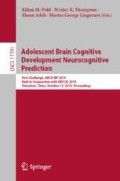Abstract
We present a novel framework using 3D convolutional neural networks to predict residualized fluid intelligence scores in the MICCAI 2019 Adolescent Brain Cognitive Development Neurocognitive Prediction Challenge datasets. Using gray matter segmentations from T1-weighted MRI volumes as inputs, our framework identified several cortical and subcortical brain regions where the predicted errors were lower than random guessing in the validation set (mean squared error = 71.5252), and our final outcomes (mean squared error = 70.5787 in the validation set, 92.7407 in the test set) were comprised of the median scores predicted from these regions.
Access this chapter
Tax calculation will be finalised at checkout
Purchases are for personal use only
References
Akshoomoff, N., et al.: NIH toolbox cognition battery (CB): composite scores of crystallized, fluid, and overall cognition. Monographs of the Society for Research in Child Development (2013). https://doi.org/10.1111/mono.12038
Carroll, J.B.: Human Cognitive Abilities. Cambridge University Press, Cambridge (2009). https://doi.org/10.1017/cbo9780511571312
Cole, J.H., et al.: Predicting brain age with deep learning from raw imaging data results in a reliable and heritable biomarker. NeuroImage 163, 115–124 (2017). https://doi.org/10.1016/j.neuroimage.2017.07.059
Dickie, D.A., et al.: Whole brain magnetic resonance image atlases: a systematic review of existing atlases and caveats for use in population imaging. Front. Neuroinformatics 11, 1 (2017). https://doi.org/10.3389/fninf.2017.00001
Dronkers, N.F., Plaisant, O., Iba-Zizen, M.T., Cabanis, E.A.: Paul Broca’s historic cases: high resolution MR imaging of the brains of Leborgne and Lelong. Brain 130, 1432–1441 (2007). https://doi.org/10.1093/brain/awm042
Fonov, V., Evans, A.C., Botteron, K., Almli, C.R., McKinstry, R.C., Collins, D.L.: Unbiased average age-appropriate atlases for pediatric studies. NeuroImage 54, 313–327 (2011). https://doi.org/10.1016/j.neuroimage.2010.07.033
Grahn, J.A., Parkinson, J.A., Owen, A.M.: The cognitive functions of the caudate nucleus. Prog. Neurobiol. 86, 141–155 (2008). https://doi.org/10.1016/j.pneurobio.2008.09.004
Hagler, D.J., et al.: Image processing and analysis methods for the adolescent brain cognitive development study. bioRxiv p. 457739 (2018). https://doi.org/10.1101/457739
Ioffe, S., Szegedy, C.: Batch normalization: accelerating deep network training by reducing internal covariate shift. arXiv e-prints arXiv:1502.03167 (2015)
Jernigan, T.: Introduction. Developmental Cognitive Neuroscience (2018). https://doi.org/10.1016/j.dcn.2018.02.002
Kingma, D.P., Ba, J.L.: Adam: a method for stochastic gradient descent. In: ICLR: International Conference on Learning Representations (2015). https://arxiv.org/pdf/1412.6980.pdf
Li, S.C., Lindenberger, U., Hommel, B., Aschersleben, G., Prinz, W., Baltes, P.B.: Transformations in the couplings among intellectual abilities and constituent cognitive processes across the life span. Psychol. Sci. 15, 155–163 (2004). https://doi.org/10.1111/j.0956-7976.2004.01503003.x
Pfefferbaum, A., et al.: Altered brain developmental trajectories in adolescents after initiating drinking. Am. J. Psychiatry 175, 370–380 (2018). https://doi.org/10.1176/appi.ajp.2017.17040469
Plis, S.M., et al.: Deep learning for neuroimaging: a validation study. Front. Neurosci. 8, 229 (2014). https://doi.org/10.3389/fnins.2014.00229
Rohlfing, T., Zahr, N.M., Sullivan, E.V., Pfefferbaum, A.: The SRI24 multichannel atlas of normal adult human brain structure. Hum. Brain Mapp. 31, 798–819 (2010). https://doi.org/10.1002/hbm.20906
Rushton, J.P., Ankney, C.D.: Brain size and cognitive ability: correlations with age, sex, social class, and race. Psychon. Bull. Rev. 3, 21–36 (1996). https://doi.org/10.3758/BF03210739
Schmitt, L.I., Wimmer, R.D., Nakajima, M., Happ, M., Mofakham, S., Halassa, M.M.: Thalamic amplification of cortical connectivity sustains attentional control. Nature 545, 219 (2017). https://doi.org/10.1038/nature22073
Srivastava, N., Hinton, G., Krizhevsky, A., Sutskever, I., Salakhutdinov, R.: Dropout: a simple way to prevent neural networks from overfitting. J. Mach. Learn. Res. 15, 1929–1958 (2014)
Tisdall, M.D., Hess, A.T., Reuter, M., Meintjes, E.M., Fischl, B., Van Der Kouwe, A.J.: Volumetric navigators for prospective motion correction and selective reacquisition in neuroanatomical MRI. Magn. Reson. Med. 68, 389–399 (2012). https://doi.org/10.1002/mrm.23228
Wang, L., Wee, C.Y., Suk, H.I., Tang, X., Shen, D.: MRI-based intelligence quotient (IQ) estimation with sparse learning. PLoS One 10, e0117295 (2015). https://doi.org/10.1371/journal.pone.0117295
White, N., et al.: PROMO: real-time prospective motion correction in MRI using image-based tracking. Magn. Reson. Med. 63, 91–105 (2010). https://doi.org/10.1002/mrm.22176
Acknowledgement
We gratefully acknowledge Prof. Michael Zhu for facilitating centralized data storage, and Institute of Inflammation, Immunology and Infectious Disease for granting access to cluster computing resources provided by Information Technology at Purdue, West Lafayette, Indiana.
The data used in this report came from the ABCD Study Collection 3104 (https://nda.nih.gov/edit_collection.html?id=3104, accessed on or before March 24, 2019). Data access was in compliance with the NDA Data Use Certification and approved by the Institutional Review Board at Purdue University. The ABCD Study is supported by the National Institutes of Health and additional federal partners under award number U01DA041022, U01DA041028, U01DA041048, U01DA041089, U01DA041106, U01DA041117, U01DA041120, U01DA041134, U01DA041148, U01DA041156, U01DA041174, U24DA041123, U24DA041147, U01DA041093, and U01DA041025.
Author information
Authors and Affiliations
Corresponding author
Editor information
Editors and Affiliations
Rights and permissions
Copyright information
© 2019 Springer Nature Switzerland AG
About this paper
Cite this paper
Zou, Y., Jang, I., Reese, T.G., Yao, J., Zhu, W., Rispoli, J.V. (2019). Cortical and Subcortical Contributions to Predicting Intelligence Using 3D ConvNets. In: Pohl, K., Thompson, W., Adeli, E., Linguraru, M. (eds) Adolescent Brain Cognitive Development Neurocognitive Prediction. ABCD-NP 2019. Lecture Notes in Computer Science(), vol 11791. Springer, Cham. https://doi.org/10.1007/978-3-030-31901-4_21
Download citation
DOI: https://doi.org/10.1007/978-3-030-31901-4_21
Published:
Publisher Name: Springer, Cham
Print ISBN: 978-3-030-31900-7
Online ISBN: 978-3-030-31901-4
eBook Packages: Computer ScienceComputer Science (R0)

